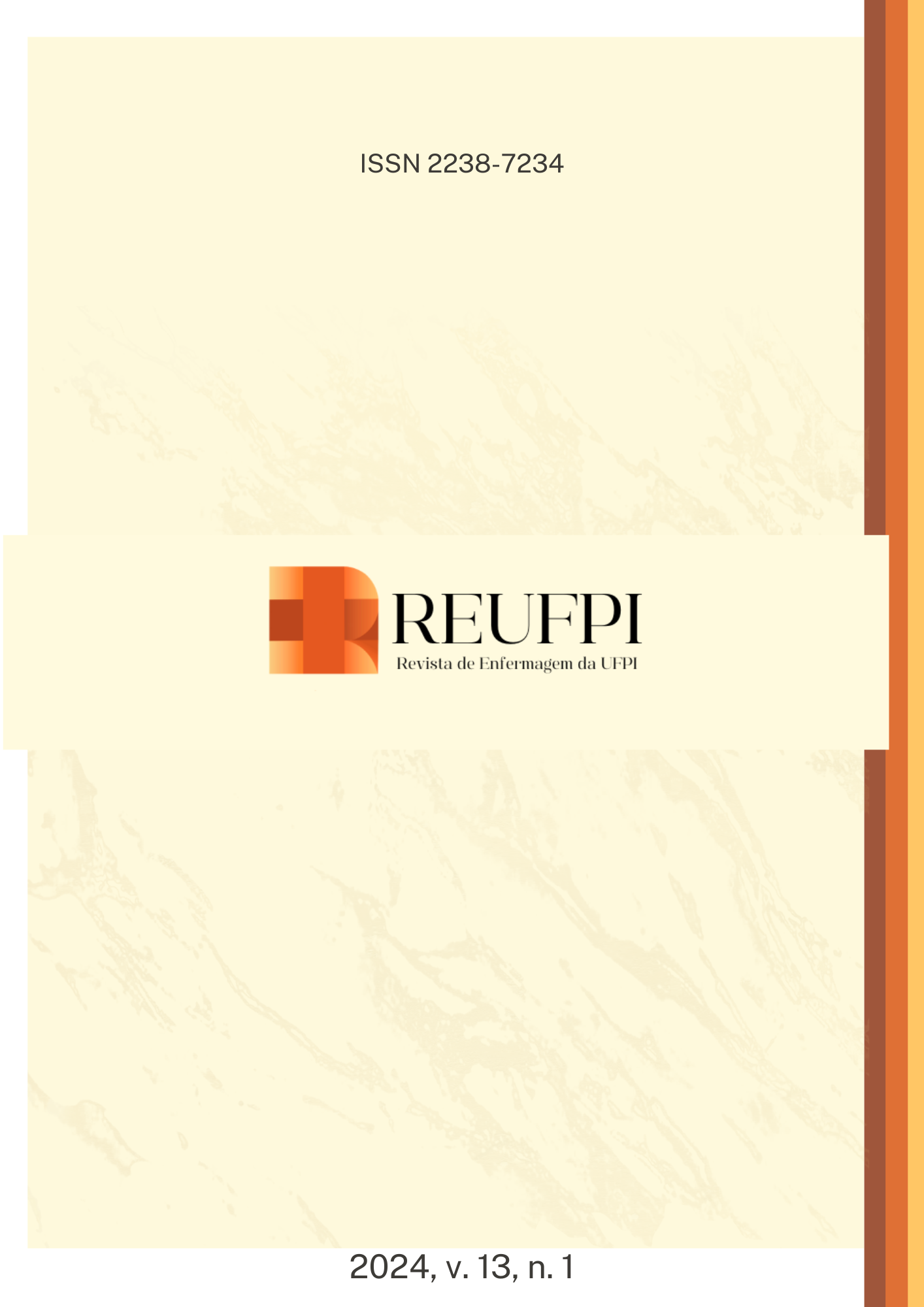Surgical outcomes of a low-cost adapted sacrospinous fixation for apical prolapse repair
DOI:
https://doi.org/10.26694/reufpi.v13i1.4722Palavras-chave:
Pelvic organ prolapse., Uterine prolapse., Surgical mesh., Operative Surgical ProceduresResumo
Objective: To assess surgical outcomes of women submitted to the adapted sacrospinous fixation (SSF) at a school hospital in northeastern Brazil for apical prolapse repair. Methods: Retrospective study with medical records of women submitted to the adapted SSF at a reference center in Brazil (2015 to 2019). All women submitted to this SSF were included, and those with pelvic organ prolapse (POP) recurrence, repair using other techniques, or unavailable medical records were excluded. The anatomical result, surgical characteristics, and associated complications and recurrence were evaluated. The chi-square and Fisher's exact test were used for statistical analysis, using a significance level of 5%. Results: A total of 198 medical records were included. The mean age was 65.1 ± 8.2 years; most had less than eight years of education, were menopausal, multiparous, and with urinary incontinence. The postoperative POP stage significantly improved at all compartments. The complication rate was 15.7%, especially due to de novo urinary incontinence (n = 12; 6%). Five cases of mesh-related complications (5%) were observed. The median follow-up was nine months, with 8.4% of POP recurrence and reoperation. POP recurrence or mesh-related complications were not associated with sociodemographic, clinical, or surgical characteristics [...].
Referências
Li J, Zhao X, Li J, Liu Y, Li T. Pelvic Organ Prolapse after delivery: Effects on Sexual function, Quality of life, and Psychological Health. The Journal of Sexual Medicine [Internet]. 9 out 2023 [citado em 13 dez 2023];20(12):1384–90. Available from: https://academic.oup.com/jsm/articleabstract/20/12/1384/7301710?redirectedFrom=fulltext&login=false
Collins S, Lewicky-Gaupp C. Pelvic Organ Prolapse. Gastroenterology Clinics of North America. Mar 2022;51(1):177–93.
Robinson MO, Linder BJ. Evaluation and Treatment of Pelvic Organ Prolapse. Minerva Medica. 1 jul 2023;114(4).
Molina EI. Aviso De Segurança De Campo Urgente - Retirada De Dispositivo Médico UpholdTM Lite with Capio SLIM Vaginal Support System [Internet]. https://antigo.anvisa.gov.br/. 2019 [citado em 25 jun 2020]. Available from: https://antigo.anvisa.gov.br/documents/33868/5482739/Carta+ao+Cliente+-+Alerta+2864/
Urogynecologic Surgical Mesh Implants [Internet]. FDA. 2019. Available from: https://www.fda.gov/medical-devices/implants-and-prosthetics/urogynecologic-surgical-mesh-implants
Ugianskiene A, Davila GW, Su T. FIGO Review of Statements on Use of Synthetic Mesh for Pelvic Organ Prolapse and Stress Urinary Incontinence. International Journal of Gynecology & Obstetrics. 20 ago 2019;147(2):147–55.
Glazener CM, Breeman S, Elders A, Hemming C, Cooper KG, Freeman RM, et al. Mesh, graft, or Standard Repair for Women Having Primary Transvaginal Anterior or Posterior Compartment Prolapse surgery: Two parallel-group, multicentre, randomised, Controlled Trials (PROSPECT). The Lancet [Internet]. 28 jan 2017;389(10067):381–92. Available from: https://www.thelancet.com/journals/lancet/article/PIIS0140-6736(16)31596-3/fulltext
de Mattos Lourenço TR, Pergialiotis V, Duffy JMN, Durnea CM, Elfituri A, Haddad JM, et al. A Systematic Review on Reporting Outcomes and Outcome Measures in Trials on Synthetic Mesh Procedures for Pelvic Organ prolapse: Urgent Action Is Needed to Improve Quality of Research. Neurourology and Urodynamics. 15 nov 2018;38(2):509–24.
Maher C, Yeung E, Haya N, Christmann-Schmid C, Mowat A, Chen Z, et al. Surgery for Women with Apical Vaginal Prolapse. The Cochrane Library. 26 jul 2023;2023(7).
Shkarupa D, Kubin N, Shapovalova E, Zaytseva A, Pisarev A, Staroseltseva O. The Novel Technique of post-hysterectomy Vaginal Vault Prolapse repair: Apical Sling and “neocervix” Formation. European Journal of obstetrics, gynecology, and Reproductive biology/European Journal of Obstetrics & Gynecology and Reproductive Biology. 1 jul 2017;214:11–5.
Shkarupa D, Kubin N, Pisarev A, Zaytseva A, Shapovalova E. The Hybrid Technique of Pelvic Organ Prolapse treatment: Apical Sling and Subfascial Colporrhaphy. International Urogynecology Journal. 17 fev 2017;28(9):1407–13.
Shkarupa D, Kubin N, Shapovalova E, Zaytseva A. The Resurrection of Sacrospinous fixation: Unilateral Apical Sling Hysteropexy. International Urogynecology Journal [Internet]. 10 jun 2019 [citado em 22 nov 2019]; Available from: https://link.springer.com/article/10.1007/s00192-019-03964-3
Hu P, Zhong C, Lu S, Lei L, Wang Y, Liu L. Safety and Efficiency of Modified Sacrospinous Ligament Fixation for Apical prolapse: Long‐term Studies and Outcomes. International Journal of Gynaecology and Obstetrics. 13 jul 2021;156(3):566–72.
Feiner B, Jelovsek J, Maher C. Efficacy and Safety of Transvaginal Mesh Kits in the Treatment of Prolapse of the Vaginal apex: a Systematic Review. BJOG: an International Journal of Obstetrics & Gynaecology. 12 dez 2008;116(1):15–24.
Meriwether KV, Antosh DD, Olivera CK, Kim-Fine S, Balk EM, Murphy M, et al. Uterine Preservation Vs Hysterectomy in Pelvic Organ Prolapse surgery: a Systematic Review with meta-analysis and Clinical Practice Guidelines. American Journal of Obstetrics and Gynecology. 1 ago 2018;219(2):129-146.e2.
Lucot JP, Cosson M, Bader G, Debodinance P, Akladios C, Salet-Lizée D, et al. Safety of Vaginal Mesh Surgery versus Laparoscopic Mesh Sacropexy for Cystocele Repair: Results of the Prosthetic Pelvic Floor Repair Randomized Controlled Trial. European Urology. Ago 2018;74(2):167–76.
Li Ow L, Lim YN, Lee J, Murray C, Thomas E, Leitch A, et al. RCT of Vaginal Extraperitoneal Uterosacral Ligament Suspension (VEULS) with Anterior Mesh versus sacrocolpopexy: 4-year Outcome. International Urogynecology Journal. 30 jun 2018;29(11):1607–14.
Zhang W, Cheon WC, Zhang L, Wang X, Wei Y, Lyu C. Comparison of the Effectiveness of Sacrospinous Ligament Fixation and sacrocolpopexy: a meta-analysis. International Urogynecology Journal [Internet]. 2022 [citado em 22 out 2023];33(1):3–13. Available from: https://www.ncbi.nlm.nih.gov/pmc/articles/PMC8739324/
Hokenstad ED, Glasgow AE, Habermann EB, Occhino JA. Readmission and Reoperation after Surgery for Pelvic Organ Prolapse. Female Pelvic Medicine & Reconstructive Surgery. 2017;23(2):131–5.
Wei JT, Nygaard I, Richter HE, Nager CW, Wein AJ, Kenton K, et al. A Midurethral Sling to Reduce Incontinence after Vaginal Prolapse Repair. The New England Journal of Medicine. 20 jun 2012;366(25):2358–67.
Zambon JP, Badlani GH. Vaginal Mesh Exposure Presentation, Evaluation, and Management. Current Urology Reports (Print). 22 jul 2016;17(9).
Kahn B, Varner RE, Murphy M, Sand P, Thomas S, Lipetskaia L, et al. Transvaginal Mesh Compared with Native Tissue Repair for Pelvic Organ Prolapse. Obstetrics & Gynecology. 2 mai 2022;139(6):975–85.
Downloads
Publicado
Como Citar
Edição
Seção
Licença
Copyright (c) 2024 Rev Enferm UFPI

Este trabalho está licenciado sob uma licença Creative Commons Attribution 4.0 International License.
Autores mantém os direitos autorais e concedem à REUFPI o direito de primeira publicação, com o trabalho licenciado sob a Licença Creative Commons Attibution BY 4.0 que permite o compartilhamento do trabalho com reconhecimento da autoria e publicação inicial nesta revista.

























